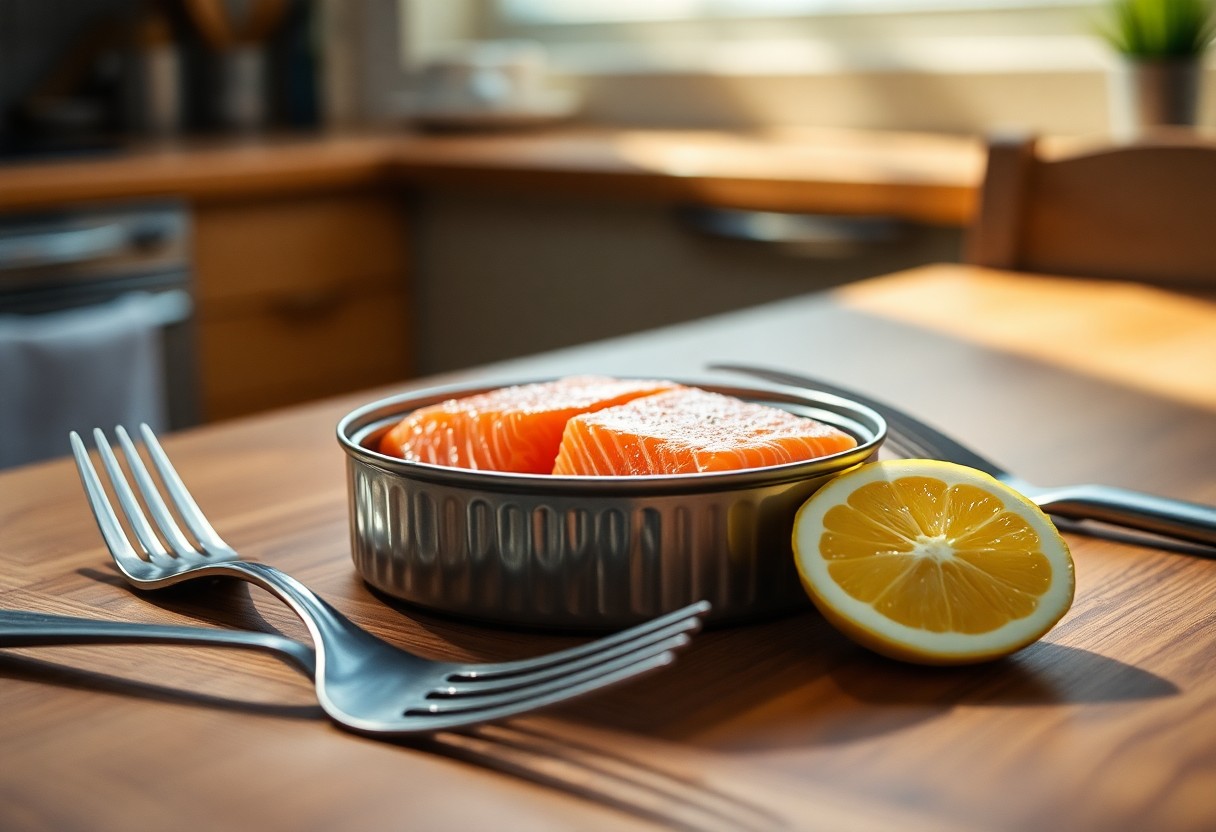Most people wonder if they can eat canned salmon straight from the can without any preparation. The good news is that canned salmon is fully cooked during the canning process, making it safe for you to eat directly. However, be aware of the potential downsides, such as high sodium content and the quality of the salmon itself. In this post, we’ll investigate into the details to help you make an informed decision about whether to enjoy this convenient and nutrient-rich seafood option without further cooking.

Key Takeaways:
- Yes, canned salmon is precooked during the canning process, making it safe to eat straight from the can without additional cooking.
- Check the label for the type of salmon; wild-caught varieties may offer more health benefits compared to farmed options.
- Consuming canned salmon can provide crucial nutrients such as omega-3 fatty acids, protein, and vitamin D, supporting overall health.

The Safety Spectrum: Is Canned Salmon Ready-to-Eat?
You can confidently consume canned salmon straight from the can, as it undergoes a thorough cooking process during canning. This robust method involves sealing the fish in a can and subjecting it to high temperatures that eliminate harmful pathogens. Since the canning process ensures safety, you can enjoy the salmon without any fear of foodborne illnesses.
Understanding the Canning Process and Preservation
The canning process preserves salmon by sealing it in an airtight container and heating it to destroy bacteria and other microorganisms. This method not only maintains the nutritional quality of the fish but also enhances its shelf life, allowing you to store canned salmon for years without refrigeration. The result is a convenient, preserved protein source ready to eat whenever you need it.
Nutritional Benefits of Canned Salmon without Cooking
Canned salmon provides a wealth of nutritional benefits, making it an excellent addition to your diet, even if consumed without cooking. It is a rich source of omega-3 fatty acids, which are known to support heart health and reduce inflammation. Additionally, canned salmon is packed with high-quality protein and important vitamins, including Vitamin D and B12, promoting overall well-being and vitality.
Notably, just a single serving of canned salmon can deliver approximately 20 grams of protein and a significant dose of omega-3 fatty acids, beneficial for brain function and cardiovascular health. Furthermore, the convenience of canned salmon makes it an easy way to incorporate healthy fats and proteins into your meals without the need for cooking – simply mix it into salads, spreads, or sandwiches for a quick nutrient boost.
Unpacking the Myths: Raw vs. Cooked Salmon
Understanding the differences between raw and cooked salmon is important for making informed choices about your meals. While raw salmon, particularly as found in sushi, has gained popularity for its unique taste and texture, cooked salmon offers a different experience. Both forms provide distinct flavors and nutritional profiles, allowing you to enjoy the benefits of this fish in various ways—raw for its freshness and cooked for its heartiness.
Flavor Profiles and Textural Differences
The flavor profiles of raw and cooked salmon diverge significantly. Raw salmon tends to have a subtle, buttery taste and a soft, melt-in-your-mouth texture, making it an ideal choice for dishes like sashimi. In contrast, cooked salmon develops a firmer, flaky texture with a richer, more pronounced flavor profile, often enhanced by spices and herbs used during cooking. Your choice between the two should reflect your personal taste preferences and the specific dish you’re preparing.
Common Misconceptions about Eating Raw Fish
Many people have misconceptions about the safety of eating raw fish, frequently associating it with high risks of foodborne illness. While it’s true that certain types of fish can carry parasites and bacteria, sustainability practices and freezing methods have improved fish safety significantly. Additionally, high-quality sushi-grade salmon is carefully handled, sourced, and stored to minimize risks, allowing you to enjoy this delicacy without worry.
Considering the safety of raw fish, it’s vital to be aware that not all seafood is created equal. For instance, sushi-grade salmon is a term applied to fish that has undergone specific handling procedures to reduce potential parasites, and it is often frozen to kill off harmful organisms. Furthermore, misconceptions around the flavor and quality of raw fish can deter you from exploring new culinary experiences. Embracing raw salmon, especially from reputable sources, can broaden your palate and introduce you to delightful taste sensations you may have never encountered before.
The Culinary Landscape: How to Enjoy Canned Salmon
Exploring canned salmon can unlock a world of culinary creativity. Versatile and packed with nutrients, this pantry staple can be incorporated into various dishes that require little to no cooking. You can toss it into salads, blend it into spreads, or even use it as a topping for pizzas. The rich flavor of canned salmon complements an array of ingredients, allowing you to develop quick, satisfying meals that don’t compromise on taste.
Creative and Quick Recipes for No-Cook Meals
Canned salmon can be transformed into delightful dishes in mere minutes. Consider whipping up a salmon salad by mixing the fish with diced avocados, cherry tomatoes, and a splash of lemon juice for brightness. Alternatively, create a salmon dip by blending it with cream cheese, dill, and capers, perfect for spreading on crackers or bagels. A simple salmon-stuffed avocado can also be a nourishing meal in itself, combining flavors and nutrients effortlessly.
Pairing Suggestions to Elevate Your Canned Salmon Experience
Pairing is where your canned salmon experience truly shines. Adding contrasting flavors can enhance its natural taste significantly. Pair your salmon with crisp, fresh greens like arugula or spinach to create a vibrant salad. A drizzle of tangy vinaigrette can brighten the dish, while fresh herbs such as dill or cilantro offer aromatic depth. Don’t overlook your favorite sauces or condiments; a dollop of spicy mayo or a squeeze of lime can take your dish to the next level.
For the ultimate sensory experience, consider complementary sides. Serving canned salmon with whole grain crackers, high-quality olive oil, and a selection of pickled vegetables introduces exciting textures and flavors. You might also experiment with cheeses, such as creamy goat cheese or sharp cheddar, which can contrast beautifully with the salmon’s richness. Incorporating seasonal fruits, like mango or citrus, can further enhance the freshness and create a delightful balance that makes each bite memorable.
Nutritional Insights: Making the Most of Canned Salmon
Canned salmon stands out as a nutritious convenience food option rich in omega-3 fatty acids, high-quality protein, and imperative vitamins and minerals. You can read more about its benefits on platforms discussing whether Food: Can you eat canned salmon right out of the can?. This means you can easily incorporate it into your diet for a quick, healthful meal or snack.
Comparing Canned Salmon to Fresh Seafood Options
| Canned Salmon | Convenient, packed with nutrients, available year-round |
| Fresh Salmon | Often richer flavor, requires cooking, generally more expensive |
Essential Nutrients Found in Canned Salmon
Canned salmon is not just tasty; it also serves as a powerhouse of imperative nutrients. It’s particularly high in vitamin D, vitamin B12, and selenium, along with a notable amount of calcium, especially if you consume the bones. These vitamins and minerals contribute to improved bone health and immune function, making it an excellent choice for supporting overall well-being.
Canned salmon provides an impressive nutritional profile that is often overlooked. For instance, a 3-ounce serving of canned salmon can yield around 22 grams of protein, which is critical for muscle maintenance and growth. Additionally, the omega-3 fatty acids present in this seafood play a significant role in heart health, potentially lowering the risk of cardiovascular disease. With elements like niacin and phosphorus, it’s easy to see how integrating canned salmon into your meals can offer numerous health benefits while saving time and effort in meal preparation.
Summing up
Taking this into account, you can confidently eat canned salmon without cooking it further, as it is pre-cooked during the canning process. This makes it safe and convenient for your meals straight out of the can. You can enjoy its nutritional benefits, including omega-3 fatty acids and protein, while saving time in the kitchen. Just be sure to check the label for any added ingredients that meet your dietary preferences. With this knowledge, you can easily incorporate canned salmon into your diet as a healthy and tasty option.
FAQ
Q: Can you eat canned salmon straight from the can?
A: Yes, you can eat canned salmon directly from the can. Canned salmon is typically cooked during the canning process, ensuring it’s safe to eat without any further cooking. You can enjoy it as is or incorporate it into various dishes like salads, sandwiches, or pasta.
Q: Is there a difference between canned salmon and fresh salmon in terms of safety?
A: Yes, there is a difference. Fresh salmon needs to be cooked to eliminate any potential parasites or harmful bacteria. On the other hand, canned salmon is fully cooked during the canning process, making it safe to eat straight away. It’s important to check the expiration date and use it before then for the best quality.
Q: How should I store opened canned salmon?
A: Once you open a can of salmon, it should be transferred to an airtight container if you’re not consuming it immediately. Store the container in the refrigerator and consume the salmon within 3 to 4 days for optimal freshness and safety.
Q: Can you eat canned salmon without any additional preparation?
A: Absolutely! Canned salmon can be enjoyed without any additional preparation. It can be eaten plain, mixed with some spices, or added to other ingredients to enhance flavor. Many people enjoy it on crackers, in salads, or as a filling for wraps.
Q: Are there any nutritional benefits to eating canned salmon?
A: Yes, canned salmon is very nutritious. It is an excellent source of high-quality protein, omega-3 fatty acids, and vital vitamins and minerals such as vitamin D and calcium (especially if you opt for canned salmon with bones). Incorporating it into your diet can contribute to overall health and wellness.

Alden Pierce is a passionate home cook and the creator of Cooking Again. He loves sharing easy recipes, practical cooking tips, and honest kitchen gear reviews to help others enjoy cooking with confidence and creativity. When he’s not in the kitchen, Alden enjoys exploring new cuisines and finding inspiration in everyday meals.
